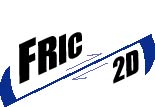 3.
FUNDAMENTALS OF FRIC2D
3.
FUNDAMENTALS OF FRIC2D  3.
FUNDAMENTALS OF FRIC2D
3.
FUNDAMENTALS OF FRIC2D As introduced in Chapter 1, FRIC2D is a command-driven computer program. In input files, command lines must be entered in order to run the program. The command-driven structure may present difficulties for some new users. The purpose of this chapter is to present new users a more completed description of FRIC2D to overcome these difficulties. This chapter of the user guide is similar to that of FRAC2D.
FRIC2D is developed to analyze frictional slip on fractures and fracture propagation. It consists of three parts: a pre-processor, numerical analysis and a post-processor (see Figure 3.1).
The pre-processor includes data input and boundary element mesh generation. Data input supplies the following data:
The generation of a boundary element discretization is based on the input data. The boundary, fractures and faults are approximated by a series of straight line segments, each of which is divided into boundary elements . The total number of boundary elements is N.
The flow chart of figure 3.2 describes the numerical analysis in FRIC2D. The procedures are described below:
The post-processor of FRIC2D places the computed results in output files: the data file and the graphics file.
The data file includes:
FRIC2D input files are designed to be human-readable. You should be able to read and understand a well-written input file without referring back to this manual.
FRIC2D reads and processes an input file line by line. After reading a line of input, FRIC2D breaks each string of characters not separated by white space (spaces, tabs, etc.) into a separate "word". For example, the line
e = 30000.0
contains three words: "e", "=", and "30000.0". Any string of characters within double quotation marks is treated as a single word.
Comments may be inserted anywhere in the input file using the comment character, "*". The comment character, "*", instructs FRIC2D to ignore the reminder of the current input line. Thus the line
e = 30000.0 *(Young's modulus e = 30000.0 MPa)
contains just three words, while lines beginning with a "*", such as
********************************************************************* frac2d.c: main program *********************************************************************
contain zero words and are ignored by FRIC2D.
Some lines in FRIC2D input files requires a large number of columns to specify the required data. Computer or terminal screens with fixed 80-character widths may be unable to display long input lines without "wrapping" part of the text back to the left-hand margin. Because files with wrapped text are often difficult to read, FRIC2D provides a line continuation character, "\". A "\" at the end of a line instructs FRIC2D to merge the following line with the present one. Because an extra space (" ") is inserted between lines as they are merged, individual words cannot be continued across lines, Thus, FRIC2D converts the lines
Thisis\really just\one line.
into the single line
This is really just one line.
FRIC2D requires you to name many of the items you define. When providing names for a fault or fracture remember these simple rules:
FRIC2D adopts the following sign conventions for various physical quantities.
For normal tensor components of stresses, sigmaxx and sigmayy, tensile stress is positive and compressive stress is negative (see Figure 3.3 a).
The shear stress sign convention is defined with respect to a small square "element" with sides parallel to the coordinate axes (see Figure 3.3).
The shear components, sigmaxy and sigmayx, are positive if they act in the positive coordinate direction (x or y) on a side with outward normal pointing in the positive coordinate direction or if they act in the negative coordinate direction on a side with outward normal pointing in the negative coordinate direction. The shear components are negative if they act in the negative coordinate direction on a side with outward normal pointing in the positive coordinate direction or if they act in the positive coordinate direction on a side with outward normal pointing in the negative coordinate direction.
The vectors include displacements, displacement discontinuities, and traction. The vector components are positive if they act in the positive coordinate direction, and are negative if they act in the negative coordinate direction.
In FRIC2D, the boundary and fractures are approximated by a series of N discrete straight line segments, joined end to end. An element is defined by two ends of a straight line. The displacement discontinuities are taken to be constant along each element.
The element's positive and negative directions are distinguished by the local outward normal to the boundary. The element's direction is positive if the outward normal is on the left side when the boundary element is traversed, that is, the boundary is traversed counterclockwise in the case of inner boundary or clockwise in the case of outer boundary (see Figure 3.4). Otherwise, the elements are negative (see Figure 3.4).
On startup, FRIC2D pre-defines a global (x, y) coordinate system in which x points East, y points North. Whenever a new element, ej, is defined, FRIC2D will link it to a local coordinate system (xbar, ybar) (see Figure 3.5).
The input parameters must be specified in the following units:
coordinates meter; Young's modulus MPa; Poisson's ratio unitless; fracture toughness MPa sqrt(meter); tensile strength MPa; tractions MPa; displacement meter.
The computed quantities (output) are given in the following units:
coordinates meter; lengths meter; angles degree; stresses MPa; displacements meter; displacement discontinuity meter.